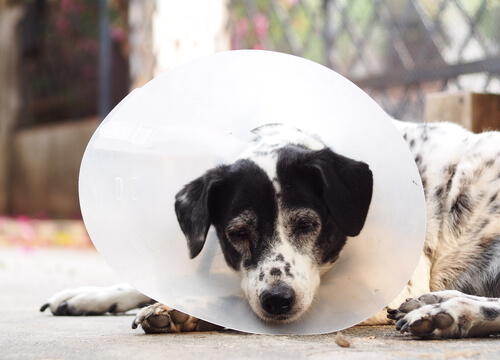Disclosure: My dog blog is supported by dog parents just like you. I only recommend products that I would use on my dogs. All opinions expressed here are my own. I sometimes earn a small affiliate commission, at no extra cost to you, when you click through the affiliate link and purchase something. You can read more about my affiliate policy here.

Out of the 3.3 million dogs who enter shelters nationwide every year, 670,000 are euthanized. So, it is important to understand how spaying and neutering dogs helps these statistics. In addition to the importance, spaying and neutering also has benefits for dogs.
February is Spay/Neuter Awareness Month. Furthermore, World Spay Day is on the last Tuesday of this month. Both awarenesses were developed to encourage the importance of animal birth control.
Awareness begins in February due to an overproduction of puppies during the Spring and Summer months. As a result, this causes overpopulation in animal shelters, which leads to euthanizing healthy dogs. Therefore, spaying and neutering dogs is encouraged by these national awarenesses.
Spaying and Neutering Process
Spaying and neutering your dog is one of the most important health decisions you’ll make as their parent. First of all, I want to clarify the difference between spaying and neutering.
Spay is the terminology for removing the ovaries and uterus of a female dog. On the other hand, neuter is the terminology for removing the testicles of a male dog.

Both require a surgery procedure with anesthesia and several stitches. However, the risks are minimal for a healthy, young dog. For instance, the traditional age for spaying and neutering dogs is six to nine months.
However, puppies as young as eight weeks old have had the procedure. Furthermore, adult dogs can have the procedure, but there’s a slightly higher risk of post-operative complications. That is to say, an overweight dog or one with health problems, has a higher risk for complications.
Most importantly, talk to your veterinarian to determine the best time for spaying and neutering your dog. In addition, your veterinarian will provide pre- and post-operative instructions for you.
Many states and counties have established programs to offer affordable and accessible spaying and neutering procedures. Furthermore, the ASPCA has a low-cost spay/neuter programs‘ page to find options in your area.

Now This Is Something To Bark About!!
After Procedure Recovery Tips
After your dog has this important procedure, you will want to help with a safe and comfortable recovery.
- Provide a quiet place indoors, away from other animals or small children.
- Prevent your dog from running for as long as your veterinarian recommends.
- Do not let your dog lick the incision area.
- Avoid bath time for at least ten days after the procedure.
- Examine the incision area daily to make sure there is proper healing. Contact your veterinarian immediately if you notice any redness, swelling, or discharge. In addition, make that call if your dog shows signs of lethargy, decreased appetite, vomiting or diarrhea.
Spaying and Neutering Importance and the Benefits

As established early in this post, spaying and neutering helps save some of the 670,000 dogs being euthanized. Therefore, dog parents having their dogs “fixed” are helping to save lives and control the dog homelessness crisis.
So, with that said, it is super important to reduce the overpopulation of dogs in our communities.
“Your community benefits. Unwanted animals are becoming a very real concern in many places. Stray animals can easily become a public nuisance. They soil parks and streets, ruin shrubbery, and frighten children and elderly people. They also create noise and other disturbances, cause automobile accidents, and sometimes even kill livestock or other pets.”
– The American Veterinary Medical Association
Research from The International Animal Health Journal reveals 30 million puppies and kittens are born yearly in America. Therefore, that is seven pets born to every human born. Consequently, the study shows that of those seven, only one out of 10 find a forever home.
Y’all, I am talking about preventing millions of dog deaths every year. So, in my opinion that is a HUGE important reason for spaying and neutering dogs. However, this important reason isn’t all, there are also medical and behavioral benefits for your dog.
Medical Benefits
- Spaying helps prevent uterine infections and breast cancer in female dogs. Furthermore, breast cancer is fatal in about 50 percent of dogs.
- Neutering helps prevent testicular cancer and prostate problems in male dogs.
- As a result of the above medical benefits, your dog will live a longer, healthier life. For instance, spaying and neutering will increase your dog’s life an average of 1 to 3 years.
Behavioral Benefits
- Your dog will be less likely to mark their territory, especially males. Therefore, you’re going to save money on carpet and furniture cleaning costs.
- Spaying and neutering helps lessen aggression and assertiveness. These two behaviors can lead to dog fights or human dog bites.
- After neutering, your dog might be less likely to mount other dogs, people, and inanimate objects.
- The need to find a mate will be gone. So, your dog will be less likely to break free on a roaming escapade. Therefore, reducing the risk of getting in a dog fight or being hit by a vehicle. Both, of which could result in death or an enormous veterinary bill.
Other Benefits

- Your life will be much easier. For instance, you will not have to clean up after a dog in heat. Plus, there is no headache from caring for a litter of puppies and then, finding them a home.
- The cost of spaying and neutering is less costly compared to the cost of a litter of puppies. To clarify, once the puppies are no longer nursing, they will need to be fed. Plus, they will need their first round of shots.
In Conclusion
So, spaying and neutering your dog can increase their lifespan and decrease serious health issues. In addition, your dog will be more manageable and better behaved.
Plus, it is cost effective, saving you money in the long run. Above all, spaying and neutering helps to reduce dog shelter overpopulation and homelessness.
Do you agree with the importance of spaying and neutering dogs? We would love to read the reasons behind your opinion.
You might be interested in these posts from our Dog Health and Wellness section on our blog.
- Bad Dog Breath – Improve with Natural Remedies
- Dogs Need to Sniff for Their Emotional Health
- Walking Your Dog – Why It’s So Important!
You can save this post to your Pinterest account by pinning one of the following images.








Wow, this is very informative! This is definitely one of the investments we will be making as soon as we get our puppy home. Love all your work! 😉
Thank you Nidia!
I am so excited for you to get your new puppy home. You are going to have so much fun being a dog mom!
Tell your new puppy that I said, “hi!”
Jeana